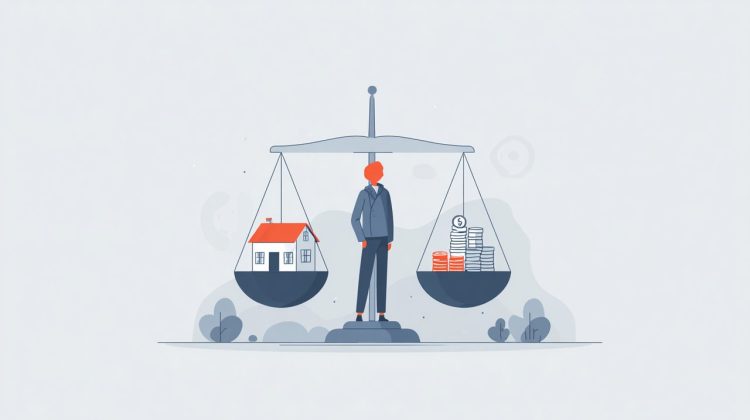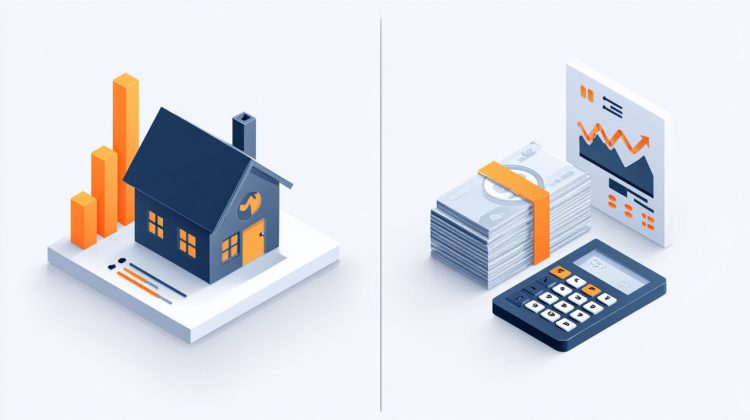For many, the allure of homeownership is powerful, often driven by the belief that it’s always the ‘smarter’ financial move. This perception, however, frequently overlooks a complex web of costs and long-term implications. A truly smart cost comparison for renting vs buying a home requires far more than just looking at monthly payments. As a financial planner and real estate market analyst, my goal is to provide a clear, data-driven framework. We will reveal the hidden expenses and long-term impacts, empowering you to make the most informed decision. This analysis will help you confidently decide between renting and buying a house that aligns with your specific financial goals.

Renting vs. Buying: Fundamental Cost Elements
Understanding the basic financial outflow for both renting and buying forms the bedrock of any sound decision. Many focus solely on the monthly headline figure, but a deeper look reveals numerous components that add up significantly. This comprehensive cost comparison for renting vs buying a home begins with the most apparent expenses.
Direct Costs of Renting
Renters typically face a more straightforward cost structure, offering predictability in monthly budgeting. These expenses are generally easier to calculate and manage.
- Monthly Rent Payment: The primary and most obvious cost.
- Utilities: Includes electricity, gas, water, and often internet/cable. These vary based on usage.
- Renter’s Insurance: Protects personal belongings from damage or theft. It is often mandatory and relatively inexpensive.
- Security Deposit: An upfront, one-time payment, usually equivalent to one or two months’ rent, refundable upon lease end.
- Additional Fees: Pet fees, parking fees, or application fees can add to the initial or ongoing costs.
Direct Costs of Buying
Homeownership introduces a more complex array of direct monthly and upfront costs. These can fluctuate and require careful consideration.
- Mortgage Principal and Interest (P&I): The core monthly payment towards repaying the loan and its interest.
- Property Taxes: Levied by local government, typically paid monthly through an escrow account.
- Homeowner’s Insurance: Protects the property structure and liability. It is a mandatory requirement for most mortgages.
- Homeowners Association (HOA) Fees: Applies to condos, townhouses, or planned communities. These cover common area maintenance and amenities.
- Routine Maintenance: Basic expenses like lawn care, minor repairs, and general upkeep. These are ongoing and essential.
Hidden Costs and Long-Term Financial Implications
Beyond the immediate monthly payments, both renting and buying involve less obvious financial considerations. These hidden costs and long-term impacts are critical for a truly intelligent Rent vs. Buy: How to Compare Costs the Smart Way analysis.
Hidden Expenses of Homeownership
Homeownership comes with a set of expenses that are often overlooked by first-time buyers. These can significantly impact the true cost of owning a home.
- Closing Costs: Fees paid at the close of a real estate transaction, typically 2-5% of the loan amount. Examples include loan origination fees, appraisal fees, and title insurance.
- Major Repairs and Upgrades: Significant expenses such as roof replacement, HVAC system repairs, or appliance upgrades are unpredictable but inevitable, making the choice of materials like roofing a critical long-term considerationMetal Roofing vs. Asphalt Shingles: Which Is the Smarter Choice?.
- Property Depreciation Risk: While property values generally appreciate, there’s always a risk of depreciation, especially in volatile markets.
- Selling Costs: When you eventually sell, expect to pay real estate agent commissions (5-6%), staging costs, and potential legal fees.
- Property Transfer Taxes: Taxes imposed by the state or local government when property changes ownership.
Long-Term Financial Upsides of Renting
Renting offers distinct financial advantages, particularly regarding flexibility and capital deployment. These can be especially appealing for individuals or those considering their initial property investment.
- Capital Liquidity: Funds that would otherwise be tied up in a down payment remain liquid. This capital can be invested elsewhere.
- Investment Flexibility: The ability to direct savings towards diverse investment opportunities like stocks, bonds, or business ventures. These often offer higher returns than property appreciation.
- No Property Value Depreciation Risk: Renters are insulated from market downturns that can erode home equity.
- Lower Moving Costs: Transitioning to a new location is often simpler and less expensive for renters.
- Financial Agility: Specific advantages of renting for first-time homebuyers include less upfront capital and greater adaptability to changing life circumstances. This allows for greater financial freedom in the short to medium term.
Smart Cost Comparison Frameworks and Tools
To effectively decide between renting and buying a house, a structured approach with specific financial metrics and tools is indispensable. This moves beyond simple intuition to data-driven insights.

Key Financial Metrics
Several analytical concepts help in a robust cost comparison for renting vs buying a home. Applying these provides a clearer picture of the financial implications.
- Price-to-Rent Ratio: This metric compares the median home price to the median annual rent in a specific market. A higher ratio often suggests renting is more favorable, while a lower ratio might indicate buying is a better value.
- Opportunity Cost: This considers the potential returns on the money used for a down payment and other homeownership expenses if it were invested elsewhere. It’s a critical element in understanding the true cost of capital.
- Total Cost of Ownership (TCO): The TCO for a home encompasses all direct and indirect expenses over a specific period, typically 5-7 years. This includes mortgage, taxes, insurance, maintenance, closing costs, and potential selling costs. This comprehensive view is essential for a complete financial assessment.
Online Calculators and Decision Models
Modern financial tools can significantly simplify the complex calculations involved in the rent vs. buy decision. Utilizing these resources provides a personalized analysis.
- Reliable Online Calculators: Many reputable financial institutions and real estate websites offer sophisticated rent vs. buy calculators. These allow for detailed input and scenario analysis.
- Key Input Variables: Users should input their specific data, including: monthly rent, potential home price, down payment percentage, interest rate, estimated property tax, homeowner’s insurance, HOA fees, and expected property appreciation rate.
- Comparative Analysis: These models typically generate a comparative breakdown of total costs over a chosen timeframe, often highlighting the breakeven point where buying becomes more financially advantageous than renting.
Personal Circumstances and Decision Factors
While financial metrics provide a quantitative framework, the decision to rent or buy is ultimately shaped by individual life stages, goals, and prevailing market conditions. These qualitative factors are equally crucial in determining how to decide between renting and buying a house.
Market Conditions and Economic Outlook
The broader economic environment significantly influences the attractiveness and feasibility of homeownership. Staying informed about these trends is vital.
- Interest Rates: Fluctuations in mortgage interest rates directly impact monthly payments and overall affordability. Lower rates generally favor buying.
- Housing Inventory: The supply of available homes affects prices. A low inventory can drive prices up, making buying more challenging.
- Local Job Market Stability: A robust and stable local economy supports property values and job security, which is crucial for long-term homeownership.
- Inflation: High inflation can increase the cost of living and potentially property values, but also the cost of materials for maintenance and repairs.
Personal Life Stage and Goals
Your current life situation and future aspirations play a pivotal role in this major financial decision. What fits one person may not fit another.
- Job Stability and Potential Relocation: A career path requiring frequent moves often makes renting a more practical and less costly option.
- Family Planning and Space Needs: Growing families often seek more space and stability, which homeownership can provide.
- Flexibility vs. Stability: Renting offers greater flexibility to adapt to changing life circumstances. Buying provides stability and a sense of permanence.
- Community Belonging: Some individuals prioritize establishing deep roots in a community, which homeownership can facilitate, alongside factors like school districts and local amenities.
Renting Advantages for First-Time Homebuyers
For those new to the housing market, renting offers distinct benefits that often mitigate the high barriers to entry and risks associated with initial homeownership.
- Lower Upfront Financial Commitment: Renting requires a security deposit and first month’s rent, significantly less than a down payment and closing costs.
- Flexibility to Test Neighborhoods: Renters can experience different areas without the long-term commitment of buying, finding the perfect fit before a major investment.
- Freedom from Maintenance Responsibilities: Landlords handle all repairs and maintenance, saving renters time, money, and stress.
- Aggressive Savings Potential: Without the immediate financial burden of homeownership, first-time buyers can save more aggressively for a larger down payment, emergency fund, or other investments. This strengthens their future financial position.
The decision to rent or buy is profoundly personal, blending financial realities with life aspirations. While the emotional pull of homeownership is strong, a rigorous, data-driven analysis is paramount. Understanding the full spectrum of costs—direct, hidden, and opportunity—is the foundation for a sound choice. This comprehensive approach ensures you can confidently decide between renting and buying a house that aligns with your specific financial goals, a step towards broader financial freedom and managing debt effectively10 Tips to Get Out of Debt: Your Practical Guide to Financial Freedom.
“The smartest financial decisions are built on facts, not just feelings.”
To gain a truly personalized perspective, I strongly recommend consulting with a qualified financial advisor. They can help you apply these frameworks to your unique situation, utilizing advanced tools for a precise cost comparison for renting vs buying a home over your desired timeline.
💡 Frequently Asked Questions
A truly smart comparison goes beyond just monthly payments, considering a complex web of direct, hidden expenses, and long-term financial implications to make an informed decision.
Direct costs include mortgage principal and interest, property taxes, homeowner's insurance, HOA fees, and routine maintenance. Hidden costs often overlooked are closing costs, major repairs, property depreciation risk, selling costs, and property transfer taxes.
Renting offers capital liquidity, investment flexibility (allowing funds to be invested elsewhere), protection from property depreciation risk, lower moving costs, and greater financial agility.
Key financial metrics include the Price-to-Rent Ratio, Opportunity Cost, and Total Cost of Ownership (TCO). Reliable online calculators are also valuable for detailed, personalized scenario analysis.








